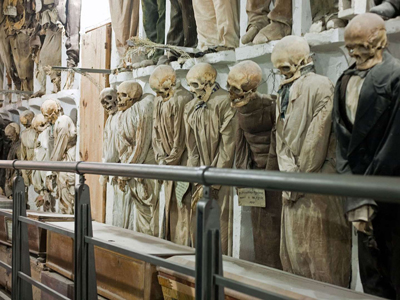
It may seem macabre, but the Capuchin Catacombs of Palermo in Sicily hosts one of the most bizarre and weird tourist attractions of the world and is also considered to contain an extraordinary historical record. It contains and exhibits approximately 8000 corpses and 1252 mummies, pinned to the walls, sitting on benches, placed on shelves, or laid in open coffins, each dressed their best Sunday attire.
Although the cult of the dead is rooted in Catholicism, in the Western tradition and culture, the dead are generally kept out of sight, in the grave, or an underground chamber, hidden from the alive. However, the Capuchin Catacombs of Palermo is an exception to it where nothing stands between the dead and the living, maybe with the very rare exception to a rope of penance, symbolizing the visitors to be respectful of the dead.
In fact, death has always been a part of life in Sicily. The Sicilians do not consider death to be a moment of terror, but a natural stage in the existence of each individual. Death in Sicily was just a continuation of a journey started on earth, and souls of the miraculously preserved would help the souls of the recently deceased reach their final destination in the afterlife.

It all started in the 16th century when the cemetery of Palermo’s Capuchin monastery became almost full, and the monks decided to excavate crypts below it, instead of expanding the traditional burial grounds. In 1599 when Brother Silvestro of Gubbio died, they mummified his body and placed it into the catacombs so that they could continue to pray with him. All these hundred years later, the mummy of the monk still remains there, at the entrance of the catacomb, to greet the visitors.

However, it is believed that the dry atmosphere in the catacombs helped the natural mummification of the dead, and the monks used to place the bodies on the racks of ceramic pipes to drip until they were completely depleted of body fluids. After a year, they rinsed the dried-out corpses with vinegar and stuffed them with hay. After that, they were dressed in their best attire and shifted to an intended place to stand for eternity.
However, while the monks were dressed in their clerical vestments, which sometimes included their ropes of penance, the military officials in their coded uniforms. Some of the bodies kept in the catacomb were embalmed and displayed in glass caskets, while others are hung in a standing position along the wall.

Initially intended to shelter the dead friars, and continuing the system for centuries, the Capuchin monks decided to offer their unique type of burial to the common residents of Palermo. However, as it was an expensive procedure, which included the maintenance and regular change of costumes, only the affluent and wealthy families could afford it, and it became a status symbol to be entombed into the Capuchin catacombs.However, the gloomy, musty catacombs have separate sections for hosting people belonging to different social statuses as well as men and women, virgin and children, monks and professionals. Today, many bodies are protected behind wire cages as some visitors tend to take bone pieces, probably as macabre souvenirs.

The ancient technique of embalming remained a mystery till an Italian biological anthropologist, Darlo Piombino-Mascali tracked down the living relatives of Alfredo Salafia, a Sicilian taxidermist, and embalmer, who died in 1933. With their help, he discovered the handwritten notes of Salafia, containing the outline of a chemical formula of formalin, zinc salts, alcohol, salicylic acid, and glycerin, with which little Rosalia Lombardo was embalmed.

While the catacombs started with Brother Silvestro of Gubbio, the last friar interred into the catacombs was Brother Riccardo in 1871. The Capuchin Catacombs of Palermo was officially closed within a decade after that, in 1880, although the last burials are from as late as the 1920s. One of the last to be interred was Rosalia Lombardo, who was only two years old when she, unfortunately, died of pneumonia. She was so beautifully embalmed that she appears to be sleeping in a glass coffin, dressed in a pretty party dress, and dubbed a sleeping beauty.